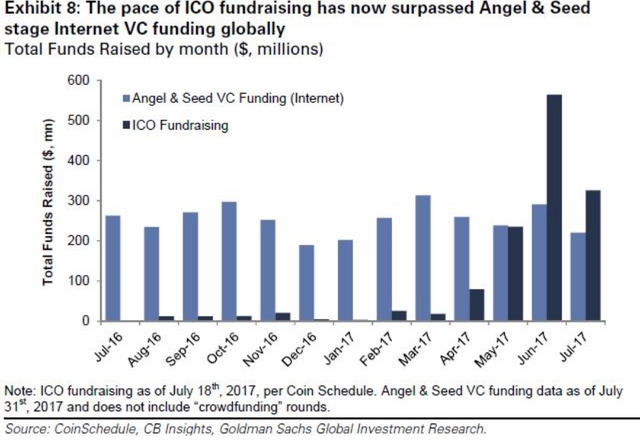Bitcoin rising like a dragon-- hits 4400$
Cryptocurrencies are in, and bitcoin has just hit a new all time high over $4000 USD over the weekend. The pace of ICOs is now surpassing angel and seed stage internet funding globally.

Bitcoin is still quite confusing, though, so I will try and shed some light on some of the core concepts of bitcoin and blockchain technology. All of this knowledge comes from my research into whether mining bitcoins would be worthwhile for myself. At the time, it was not. While mining may not be viable for you, investing in bitcoin could still be.
Let’s start with the blockchain, on top of which bitcoin is built. As the name suggests, the blockchain is a software construct representing a chain of blocks, but what does this chain help bitcoin solve? The chain is the ledger. Imagine a bank: when you go in to withdraw cash, the bank keeps a centralized record of this transaction in a ledger somewhere. The blockchain represents that somewhere, and secures the records for all bitcoin transactions through various cryptographic techniques.
This is usually where it gets really confusing. Cryptography is a technique used for encoding messages such that someone intercepting the message will likely not be able to directly read it. The most simple cypher to understand, a cypher being a mechanism by which to apply cryptography, is a caesar cypher (more information: https://learncryptography.com/classical-encryption/caesar-cipher). In this basic cypher, a message’s letters are all shifted by a specific number of letters. For example, with the 26-letter alphabet and a caesar cypher of 5, the following message:
"Hello, bitcoin is going up like crazy!"
Would become:
"Mjqqt, gnyhtns nx ltnsl zu qnpj hwfed!"
This cypher is basic, though, and it’s quickly noticeable how easy to crack this kind of encryption would be. Unlike the caesar cypher, blockchain technology is built on top of very robust cryptographic mechanisms. At the core, the SHA-256 algorithm (SHA = Secure Hashing Algorithm) is used to generate a hash for each transaction to be placed in a block. By hashing all transaction records this way, all resulting data to be stored in a blockchain block is only 256 bytes, greatly reducing the amount of space needed to store all transactions. Hashing works by algorithmically generating a unique set of X bytes (in this case 256) from any input length, meaning even massive transaction records with many megabytes of information will still be condensed into this small, 256 byte format.
On top of hashing, encryption comes into play heavily for registering an actual transaction. By using public key encryption, along with the process of digitally signing a message, transactions can be authenticated by the recipient and known to be from whom they say they are with absolute certainty.
Digital signatures are used throughout the web in many applications, and I'll try to summarize them very quick. The sending party creates the hash bytes as described, and encrypts that with their private key (something that no other person should have, and that only their public key can decrypt). The receiving party then receives a transaction, and hashes it as well. By using the public key of the sender, the receiver then checks the decrypted hash with the one they generated, therefore both ensuring the sender sent the transaction while simultaneously ensuring the transaction was not tampered with on the wire.
So now that we‘ve covered the underlying encryption and how it secures bitcoin, let’s talk about it’s uptick in value recently. Over the past month, bitcoin has literally more than doubled in value. Will it keep going up?
That is everyone’s question, and I don’t have the answer. I believe it will, because there is a limited total number of bitcoins that will ever go into circulation. As someone on Twitter put it well, there are not enough literal bitcoins for every millionaire in the world…only 21 million coins will ever be produced.

While maybe sounding odd, this max bitcoin count is actually written into the software. Through a series of halving events, bitcoin has an exponential decay function built into it’s distribution of new currency, eventually halting altogether when reaching 21 million coins. The author of bitcoin imagines this happening in roughly a hundred years.
That timing prediction comes from the fact that the algorithms used to secure bitcoin are constantly being upped in difficulty for mining machines to compute. By doing so, the time to mine any 1 block is held constant at about 10 minutes, regardless of hardware advances.
All in all, bitcoin is in my mind a no brainer investment. While buying right now is likely unwise, as the price has just hit an all time high, I will definitely be keeping an eye on both the single coin price and the total market capitalization as more and more coins are distributed into the network. To end on a funny note, I just imagine what I'll be telling my grandkids one day...

Source: Bitcoin & Blockchain Basics
https://www.linkedin.com/pulse/bitcoin-blockchain-basics-benjamin-hendricks
Bitcoin is growing great and have a great future and its making the market
Susprsingly, there has still not been a really heavy correction.
Congratulations @indiantraveller! You have completed some achievement on Steemit and have been rewarded with new badge(s) :
Click on any badge to view your own Board of Honor on SteemitBoard.
For more information about SteemitBoard, click here
If you no longer want to receive notifications, reply to this comment with the word
STOPThis is so helpful.